THE NEW SURREAL PAINTING HAs BEGUN.
PROGRESS IMAGES OF THE NEW PAINTING WILL BE POSTED HERE PERIODICALLY.
The title and story of the painting to follow at a later date.
‘the moirai destinies’
2023
One of the most challenging aspects of creating a new surreal painting is finding an appropriate title and story that suggests an explanation of the work in broad terms but does not offer a definitive interpretation. This exercise is a difficult and often frustrating task but an important one. The title and story should convey an explanatory starting point which allows the painting’s meaning to grow and expand over time.
The Moirai Destinies
The concept of a universal principle of natural order and balance.
________________________________________________________________________________
In ancient Greek mythology, the Moirai (often known in English as the Fates) were the personifications of destiny.
The role of the Moirai was to ensure that every being, mortal and divine, lived out their destiny as it was assigned to them by the laws of the universe. For mortals, this destiny spanned their entire lives and was represented as a thread spun from a spindle (wiki) or as depicted in this painting, a series of trailing clouds.
The Moirai were considered the enforcers of fate and the singularity they inhabit in the pantheon in this painting is a point in time and space at which circumstances result in unforeseeable, infinite changes.
An altered interior scene of the Dôme des Invalides and several photos from past trips to Paris and Istanbul make up the major elements in this painting.
The Moirai Destinies - video clip
Original oil painting by Robert Vanderhorst.
Image & Video by Robert Vanderhorst
Audio by Nash the Slash
‘HOPE’
oil on canvas, 60” x 18”, 2021
Several years ago I started thinking about a new surreal painting depicting a beach scene in Florida near the turn of the century.
At the time I began the design for this painting a pandemic was unthinkable. Our lives were relatively normal and predictable. Unfortunately times have changed.
This is a story of premonition, the drama of a looming event remaining ambiguous.
Participants are dressed in period costumes. The colour tone was created to replicate a sepia style photograph. A small selection of elements and characters are of a more modern time but the intent is to represent the late 1800s to early1900s.
This was a time of dramatic change. The beach was a sanctuary for most. They came to relax, to play, to talk, to think or to dream. But for some people, the beach was more. World events were moving at a rapid pace and this was a place where a few believed the future would be revealed.
The stone bathers are by Henry Moore and their placement in the painting was inspired by Picasso’s painting of ‘The Bathers’ (https://poster.mysupadupa.com/products/picasso-the-bathers). They represent a care-free and joyful time.
Standing behind the stone bather in the foreground is a gentleman in a top hat, his shape being altered and aggressively blown into a liquid state. This image was inspired by the fluid creations of Dutch fashion designer Iris van Herpen (https://www.irisvanherpen.com/) . A large black crow in flight is heading out to sea and in the distance a man is seen sitting, dressed in a heavy winter parka. Each of these images is a symbol of a darker future.
Several beach visitors are pointing towards the horizon but most are blissfully unaware of any advancing event. Something is definitely there. They can see it. Something is coming.
The ancient myth of Pandora represented the triumph of hope over despair. Her namesake was a frequent visitor to this beach. She is seen standing at the water’s edge captivated by the sound and movement of the waves. Before Pandora and two of her siblings could bear witness to the unimaginable changes rushing towards them, they will be mysteriously transported to Paris in the painting, ‘La Belle Époque’.
On the far right side of the painting, Pandora’s youngest sister stays behind on the beach, intrigued by the small blue globe floating before her.
The child has named the globe “HOPE”.




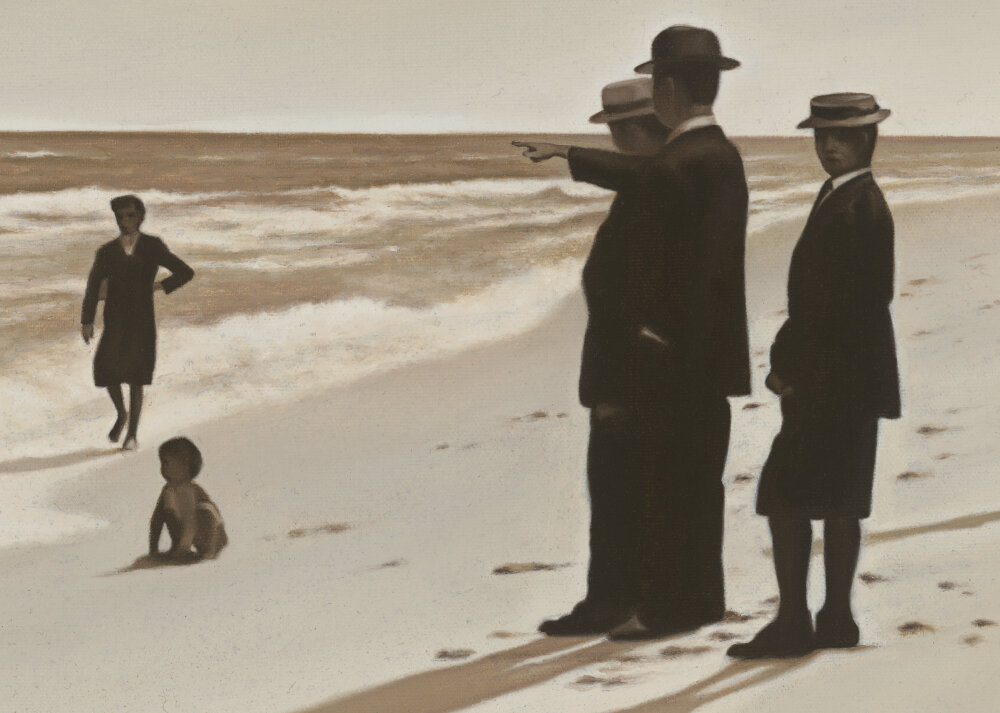





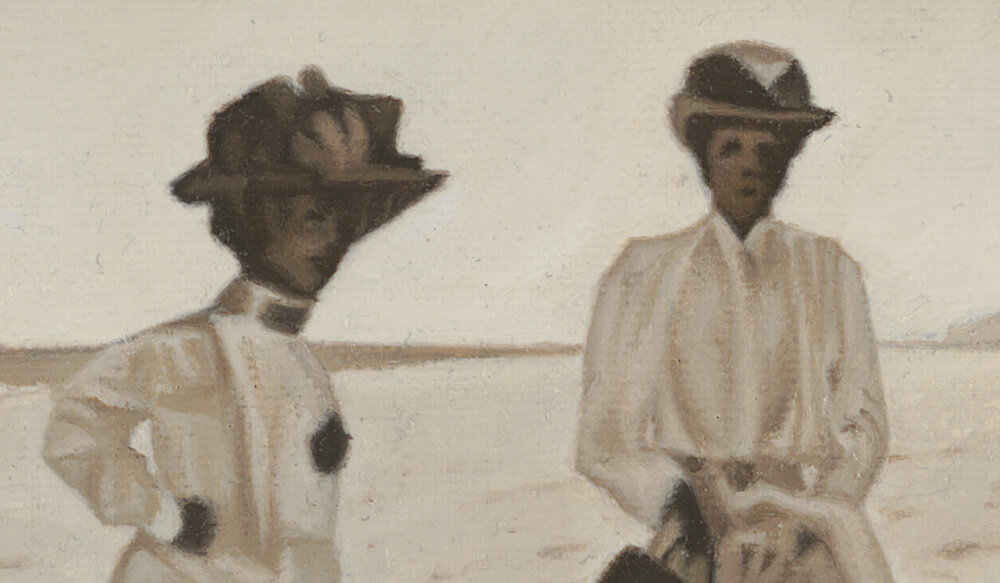






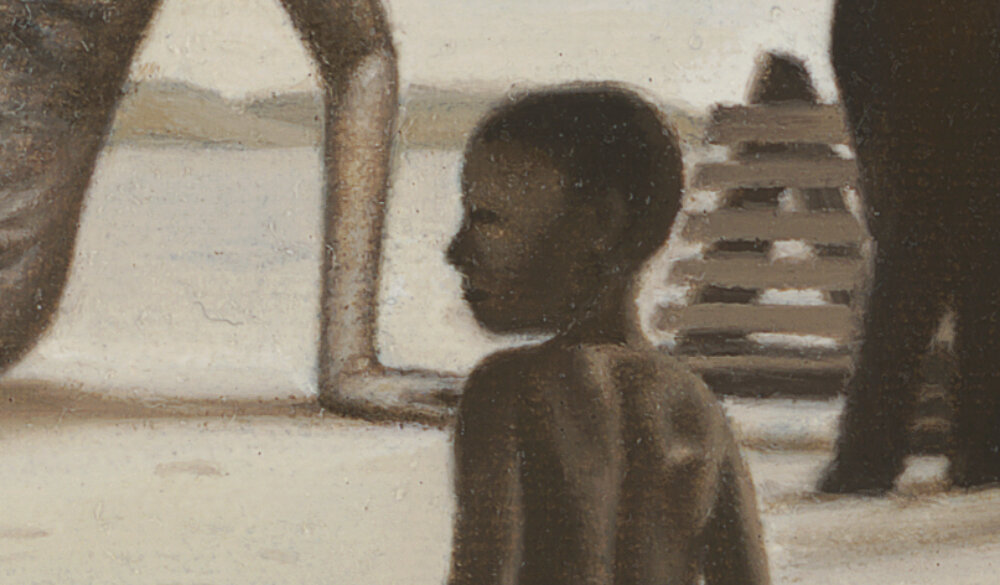
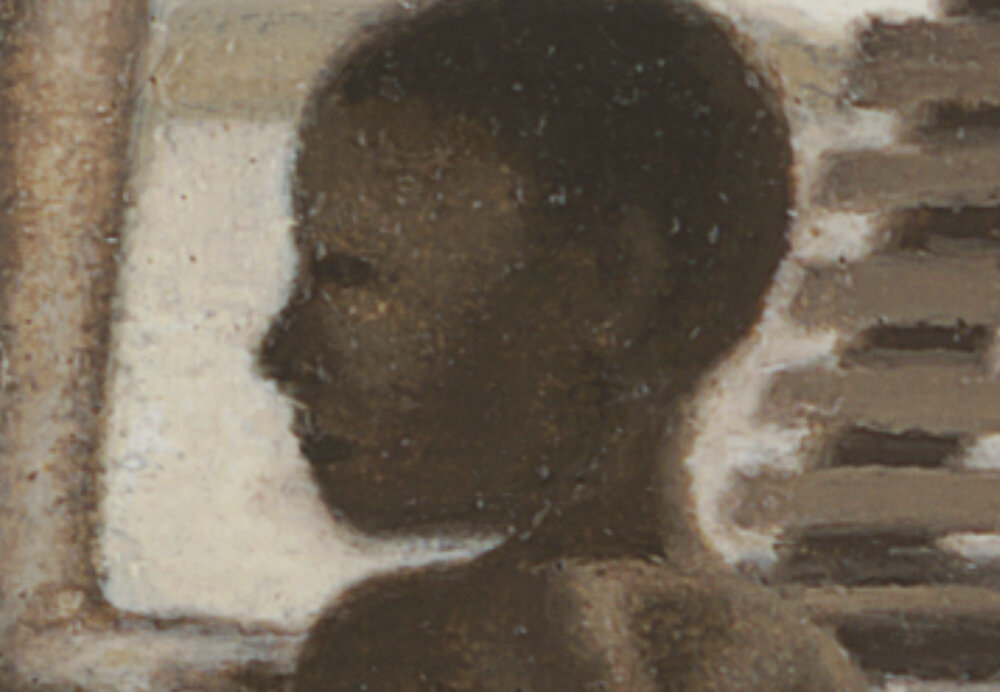






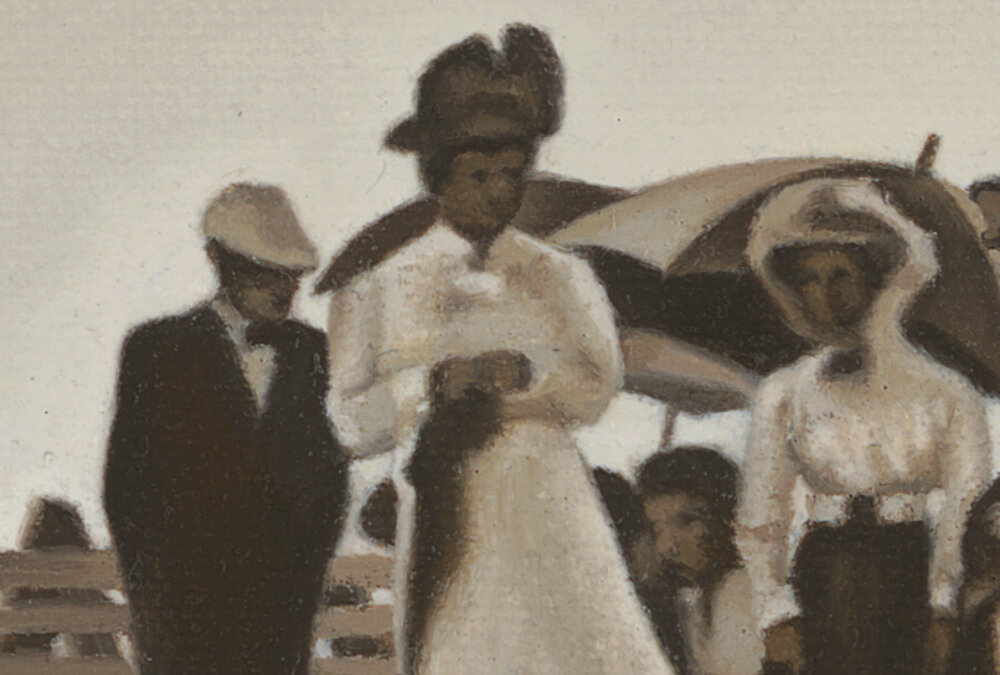

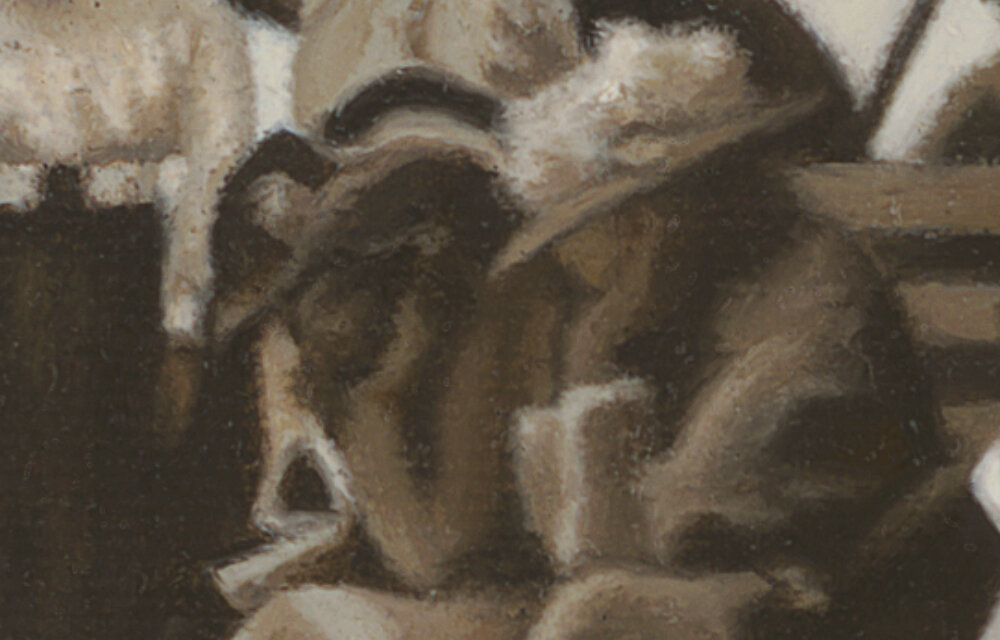

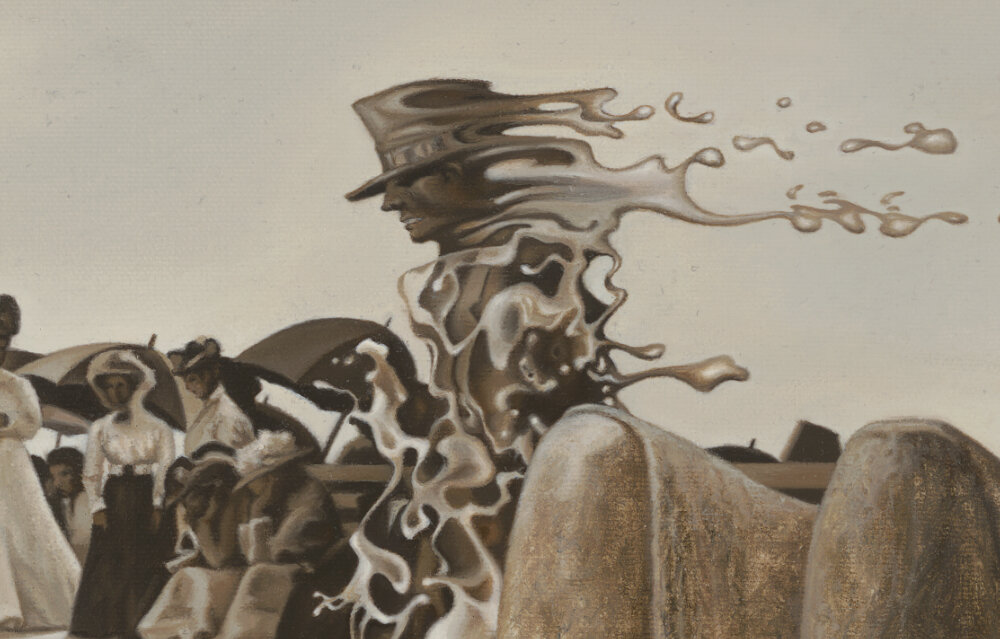















FATE’S PASSAGE
Painting by Robert W. Vanderhorst - Music by Nash the Slash
2014, Oil on Canvas, 24” high by 18” wide.
The scene takes place in the Jardin des Plantes in Paris.
At the end of the light dappled gravel path is the Museum of Natural History.
The ‘Museum’ is on this side of the doorway. The mother and her young son are going out through ’Fate’s Passage’. As they exit, mother and son gradually disappear into the space around them.
The man standing at the doorway is the museum’s greeter.
The astronaut has recently arrived, confused but intrigued. Near the exit, the shadow of a stooped Churchill leans heavily on his cane and the grey figure of Napoleon stands on the balcony suggesting that they have been guests of the museum for quite some time.
This ‘Museum’ is a spectre of our future.
Last thing I remember, I was
Running for the door
I had to find the passage back
To the place I was before
"Relax, " said the night man,
"We are programmed to receive.
You can check-out any time you like,
But you can never leave! "
Hotel California - The Eagles
‘LOST’
video for the painting , ‘LOST'.
Music by Saturation Divers © 2021 Brilliant Fish Music/Jim Field, SOCAN
This painting explores the concept of choice. The choices we’re presented, the ones we make, the ones we don’t and the ones that are made for us. Through these choices, we can either find our way or we can be ‘LOST.
Two divers, who know each other from past adventures, find themselves in an unlikely environment swimming down an empty country road next to a farmer’s field. The scenery is bleak and grey with the only colour being a hint of silvery purple on the distant tree branches. The corn field next to the road had been long since been hacked down. Snow fills the furrows and the remaining bleached grasses at the roadside crackle as the wind shakes off thin shards of ice.
A light snow is falling. One of the divers notices a series of repetitive rectangular shapes running along the tree line and begins heading across the field towards them. A set of doorways come into focus through the cold mist.
The other diver stops, hovering above the dirt road. He’s confronted by a foreboding black carriage with two harnessed horses standing before him, motionless.
The diver stares directly ahead and is transfixed by the stars in the universe that envelopes the darkness of the horse’s head.
The thoughts swirl in his head, ‘Where am I? How do I get home?’
magritte’s Dark Angels
44” x 28”, Oil on Canvas, 2015
‘Magritte’s Dark Angels’, is a somber and pensive impressionist style Paris night scene inspired by Belgian Surrealist Rene Magritte’s painting, ‘Le Mal du Pays’ (Homesickness) created in 1940.
A Paris night scene. The painting features two dark angel-like figures with raised wings standing on the Pont Alexander III bridge overlooking the River Seine. The bridge, illuminated with a line of ornate Art Nouveau iron gas lamps, reflects the exuberant Beaux-Arts style of the late 1900s.
Two travellers pause in the middle of the bridge huddled beneath an umbrella, perhaps reading a map. In front of the travellers a third individual, dressed in a black overcoat and hat, sits atop a penny-farthing style large wheeled bicycle. He’s stopped and hovers a few feet above the pavement facing one of the angels. The scene in the interior space of the spokeless wheels appears slightly altered, evoking a lightness in atmosphere.
The cyclist is watching with curiosity and quiet anticipation as one of the dark angels reads a note from home.
"Everything we see hides another thing; we always want to see what is hidden by what we see". Rene Magritte
The painting Homesickness (1940) features a forlorn Magritte as an angel leaning over a bridge contemplating the river, his sorrow and pain; perhaps even suicide. He was losing his wife Georgette as result of an affair and his home to the Nazi occupation during WWII. The lion, representing his wife Georgette, is not threatening or menacing and looks away disinterested. The painting was completed in 1940, the same year Nazi Germany entered and occupied Belgium in WWII.
____________________________________________________________________________________________________
René Magritte was born in Lessines, Belgium in 1898. On 12 March 1912, his mother committed suicide by drowning herself in the River Sambre. This was not her first attempt at taking her own life; she had made many over a number of years, driving her husband Léopold to lock her into her bedroom. One day she escaped, and was missing for days. Her body was later discovered a mile or so down the nearby river. According to a legend, 13-year-old Magritte was present when her body was retrieved from the water, but recent research has discredited this story, which may have originated with the family nurse. Supposedly, when his mother was found, her dress was covering her face, an image that has been suggested as the source of several of Magritte's paintings in 1927–1928 of people with cloth obscuring their faces, including Les Amants.
Rene Magritte’s home life was not an easy one. He moved frequently with his two brothers when he was very young. Magritte's father died in 1928 of diabetes leaving Rene without parents. He was alone except for his loving wife, Georgette. They were living in the suburbs of Paris at the time. After a three year sojourn to Paris, they too would become homesick for Belgium and came home to Brussels where they could be near their remaining family members.
Six or seven years later Rene Magritte's life started to change. Leaving his home in Brussels, he went on his trips to London to visit Edward James and ELT Mesens to prepare for his exhibitions. During that time Rene became involved with the young surrealist model known as the "Surrealist Phantom" of 1936, the artist Sheila Legg, who posed for surrealist events with Dali and others and was one of the most photographed surrealist woman at the time. According to one source: "Magritte fell in love with her." Magritte arranged for his friend, surrealist poet Paul Colinet, to entertain and distract Georgette, but this led to an affair between his wife and Colinet.
Rene Magritte fled Brussels and his marital problems for France in May 1940, five days after German troops invaded Belgium and Holland. He spent three months in Carcassonne, France, with Paul Eluard and Scutenaire but returned to Brussels and remained there during the German occupation of Belgium in World War II.
Excerpts from The Biography of Rene Magritte and Wikipedia
video for the painting, 'La Belle Époque'.
The music is a blend of a previously unreleased composition by Nash the Slash paired with Erik Satie's Gymnopedie
______________________________________________________________________________________________________
“La Belle Époque – Portrait from the Edge”
SOLD - PRIVATE COLLECTION, BERLIN, GERMANY
‘Portrait from the Edge’ foreshadows the coming end of La Belle Époque. Even though the intent of this painting is to convey the optimism, excitement and freedom of this period of time in Paris, the insertion of the panther makes it clear that there is still a sense of apprehension looming in the air and that we must always remain aware.
“La Belle Époque – Portrait from the Edge”
The image of a delineated dream where memories are selective and time fluid, all destined to repeat until extinction.
La Belle Époque was a period of French and Western history. It is conventionally dated from the end of the Franco-Prussian War in 1871 to the outbreak of World War I in 1914. Occurring during the era of the French Third Republic which began in 1870, it was a period characterised by optimism, regional peace, economic prosperity, colonial empires, and technological, scientific, and cultural innovations. In this era of France’s cultural and artistic climate, particularly within Paris, the arts flourished with numerous masterpieces of architecture, literature, music, theatre and the visual arts.
This story begins in Paris in winter.
It is late afternoon. The sun is obscured by a snowy mist and the light is beginning to fade into twilight. A bed of soft white snow has recently fallen, covering the trees and pathway leading towards the Eiffel tower in the distance. The atmosphere is buoyant and the air chilly but not unpleasant for this time of the season. The ornate baroque style gas lamps lining the pathway have just been turned on and begin to glow. From the base of each lamp the light floats upwards, reminiscent of childhood Christmas lights that would send bubbles rising to the top through coloured liquid. Once reaching the glass lamp enclosures, the light begins to escape in star-like patterns, floating away and eventually disappearing in the cool air. Lamps of a simpler design follow the pathway between the large, bare chestnut trees that line the perimeter of this magnificent promenade. Their warm glow adds a phosphorescent quality to the surrounding whiteness.
A young couple are seen casually strolling side by side down the promenade, ignoring the odd events taking place immediately around them. They are joined by a muscular black panther walking slightly to the rear of the couple. The ownership of this animal is unclear. Their clothing has taken on the dark patterned spots of the panther’s fur, suggesting that they are either acquainted in some manner or indicating the development of a more ominous association that could perhaps manifest itself in the future.
Near the terminus of the pathway under the tower, a man in a bowler hat can be seen parting open a large curtain that leads to an alternate horizon flooded with light. This image was inspired by a 1955 painting by Belgian surrealist, Rene Magritte titled 'Mysteries of the Horizon'.
Two dark horse-drawn carriages appear on the right side of the pathway. The carriage in the distance is approaching at a slow trot, releasing more floating light from the cabin’s interior. The light is emanating from the rear window, opening the possibility of an alternate environment outside of the carriage’s present reality, perhaps the same environment that is revealed through the curtain at the end of the pathway.
The second carriage has stopped closer to the couple walking. This carriage has an unusual story to tell.
In early 2018, I began work on a surreal painting depicting a beach scene near the turn of the century. The entire image has been painted as an old sepia-toned photograph. Some of the elements and characters are from a more modern time period but the painting is intended to represent the late 1800s to the early1900s, the same time period known as La Belle Époque in Paris. This painting is still in progress.
Three children are seen playing on this beach.
The same three children are now seen escaping the beach in the sepia-toned painting and are relocating to Paris. The beach landscape envelopes the interior of the first carriage. Sand is gently flowing from the carriage doorway onto the snow covered pathway. The children are presented in the same pose and are depicted in the same sepia tones as in the beach painting: a shift in a moment in time and space, a reoccurring theme in many of my works.
We now see these three children in the snow, curious about their new surroundings but, much like the couple walking, they are unconcerned or unaware of the circumstances around them.
The same cannot be said of the carriage driver. He has been here before. He has driven many others to this point in time, but not necessarily to this same location. As history continues to repeat itself, his passengers often find themselves captured in history’s recurring loop.
The driver notices the panther paying close attention to the youngest child. A moment of apprehension fills the space between them. He is aware of the possible danger and ready to react if necessary, or so he believes.
On the left side of the promenade the atmosphere is more relaxed. A small herd of elephants appears out of the snowy mist walking casually away from the Eiffel Tower. The Tower itself is an architectural marvel, impossible in its structure and dominant in its appearance; it is an everlasting monument to this moment in history.
A young cellist is sitting quietly under one of the ornate lamps. With her eyes gently closed, the young girl is seen absorbing the fragrance of the cool air around her and contemplating the music she hears in her mind. Shortly she will begin to play.
Her choice will be Erik Satie’s, Gymnopédies and Gnossiennes.
‘Portrait from the Edge’ foreshadows the coming end of La Belle Époque. Even though the intent of this painting is to convey the optimism, excitement and freedom of this period of time in Paris, the insertion of the panther makes it clear that there is still a sense of apprehension looming in the air and that we must always remain aware
















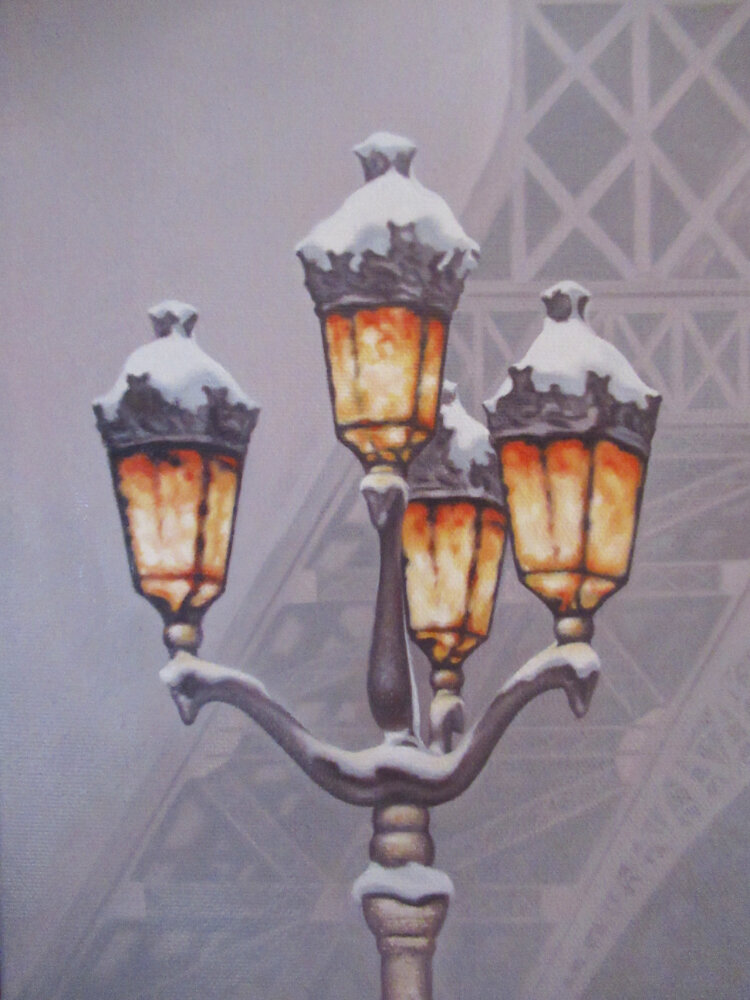








‘And You Thought You Were Normal’
A Documentary Film About Nash The Slash
IN PRODUCTION
And You Thought You Were Normal: A Documentary Film About Nash The Slash tells a universal story of an artistic struggle. This film illustrates an artist who pursued his vision without compromise gaining a cult following through his unwavering dedication to his Gothic obsessions, punk aesthetic and musical eccentricities. Validated by contemporaries such as Gary Numan and Iggy Pop and opening shows for mega stars like The Who, The Tubes and Devo, we witness how Nash flirted with fame but ultimately decided to follow the path of an anti-star.
Through extensive interviews, archival footage and rare imagery, we are introduced to the characters closest to Nash with whom he collaborated, mentored, and inspired.
Having left this world making a hefty contribution to Canadian culture, this film shows how and why this outsider artist had such strong international appeal and why his work is still very relevant to a new generation of music lovers today. In production, release date still to be announced.
www.andyouthoughtyouwerenormal.com
Facebook, Instagram & Twitter @youwerenormal
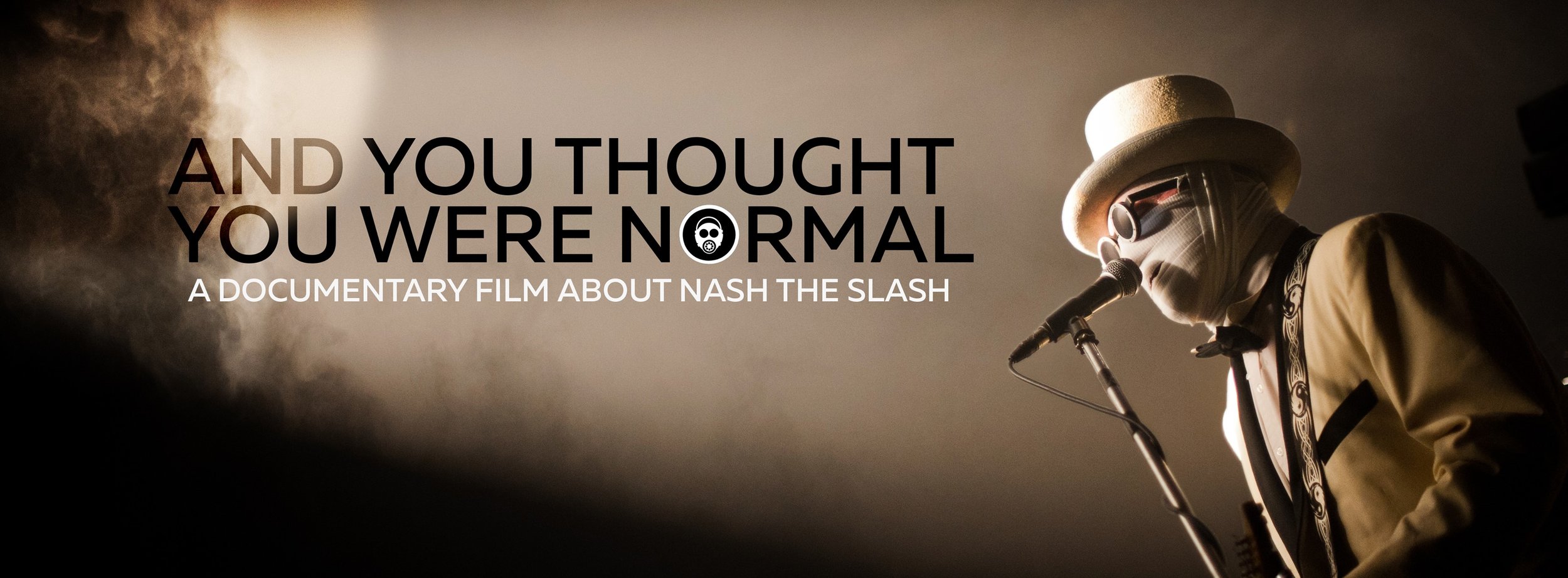










I AM HONOURED THAT MY PAINTING
‘THE BLUE ANGELS’
was acquired by
THE SMITHSONIAN AIR & SPACE MUSEUM
in Washington, DC.
’THE BLUE ANGELS’ by Robert W. Vanderhorst - Oil on Canvas
In 1995, with the assistance of Admiral Skip Furlong, former Vice President of the United States Naval Aviation Museum Foundation and Capt. Bob Rasmussen, former Director of the National Museum of Naval Aviation at NAS Pensacola, Florida, Vanderhorst created a 3’x 6’ oil painting celebrating the 50th. Anniversary of the Blue Angels.
The painting depicts all eight of the aircraft used by the Blues since their inception in 1946.
Cdr. Butch Voris originated the Blue Angels and flew the first F6F Hellcat for the team in 1946. He also named the new Navy flight demonstration team after a night club in New York City called “The Blue Angel”.
After completion in 1995/96, the painting went on display in the Atrium of the United States National Museum of Naval Aviation at NAS Pensacola, Florida for 2 1/2 years.
The painting has been acquired by the Smithsonian Air & Space Museum in Washington DC.
Below are listed the first flight leaders for each aircraft used by the Blues.
F6F “Hellcat” - Cdr. Butch Voris, Team Leader 1946
F8F “Bearcat” - Lcdr. Dusty Rhodes, Team Leader 1947-50
F9F-5 “Panther” - Lcdr. Ray Hawkins, Team Leader 1952-53
F9F-8 “Cougar” - Cdr. Zeke Cormier, Team Leader 1954-56
F11 “Tiger” - Cdr. Ed Holley, Team Leader 1957-58
F4 “Phantom”- Cdr. Bill Wheat, Team Leader 1967-69
A4 “Skyhawk” - Cdr. Ken Wallace, Team Leader 1974
F18 “Hornet” - Capt. Gil Rud, Team Leader 1986-88
‘IN THE ABSENCE OF LIGHT’
has been acquired by
THE CANADIAN WAR MUSEUM
in Ottawa, Canada
for their permanent art collection.
I was inspired to create this painting by a photograph.
The photo was a haunting image a young Afghan girl
standing before a burned out Russian tank taken by
my dear friend, Mike Frastacky two years before
he was killed by the Taliban for funding and
building a school for the children of the
village of Nahrin in Northern Afghanistan.
A young Afghan girl stands in a large room staring directly towards us. Her haunting gaze and sad expression give us an insight into the suffering she’s endured.
The space in which she stands is reminiscent of a room in the British Museum which houses the Parthenon Marbles. The ceiling is open to the elements and the friezes along each wall no longer depict glorious battles from Greek history but now are symbolic of the violence of all wars. The stone is alive and bleeding, a hellish, permanent reminder of the destruction and suffering that comes with violent conflict.
A sculpture of a dismembered tank stands alone in the room, the barrel slightly lowered in defeat but still ominously pointing as a possible threat. Two generals guised as polo players enter the room from opposite directions. Their game is about to begin. Power is the motivation and the damage and misery caused as a consequence of their battle is irrelevant. Victory is the only goal that matters. Two peasants with brooms in hand stand ready to clean up the debris left behind.
As a commentary on the transitive nature of nations, a large Easter Island statue stands in the middle of the room, balancing precariously on a thin pinnacle. Low stanchions placed to protect the relief sculptures become confusing escape ladders running along each side wall. One such ladder appears overtly out of place over a baseboard and then disappears into an atmospheric floor. The top of a nearby bench becomes a skyscape retreating into the floor and offering another possible escape portal.
The young girl’s expression is one of sadness. Her eyes are caught in shadow and at first glance, seem empty. Looking deeper into the darkness, the space comes alive. Stars appear, emblematic of her hope and desire for a new life. Her clothing is also a symbol of hope. The blouse is made of coloured glass, inspired by the magnificent stained glass windows of the Chartres Cathedral located just outside of Paris. The leaves in her brightly patterned jacket become 3 dimensional and begin to fly away like doves in a gentle breeze.
Michael Frastacky’s wish for the children of the 10 villages that surround the district of Nahrin in Northern Afghanistan was for peace, hope and freedom through education. His effort in building this school embodies what it means to be a Canadian and highlights Canada’s commitment to stability, peace and a positive future for Afghanistan.
His school remains as a light in the darkness for over 1000 children.















